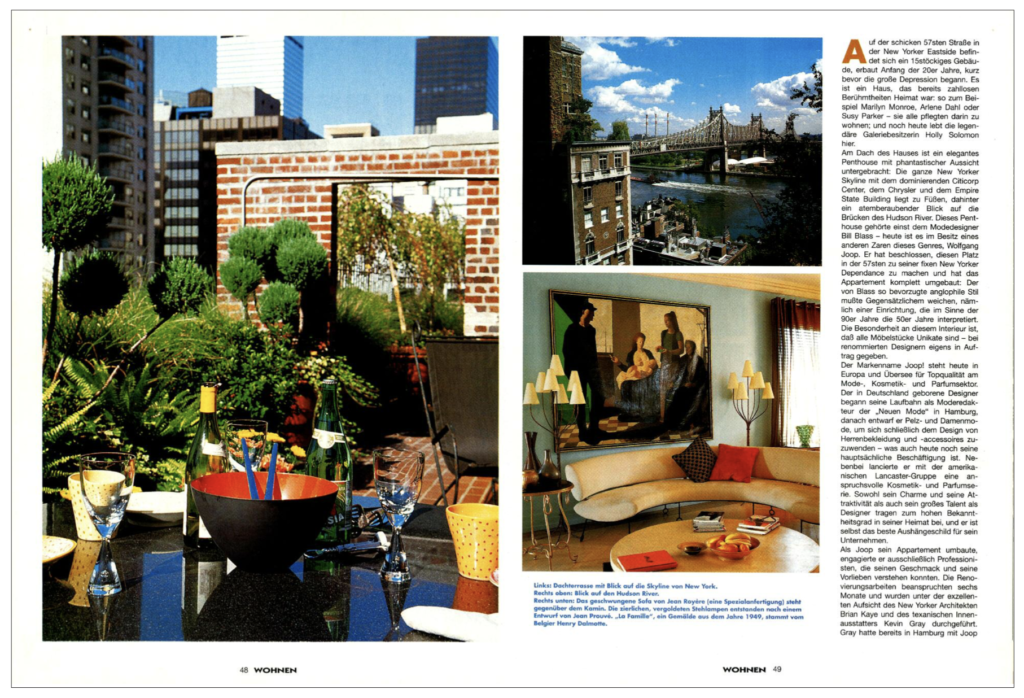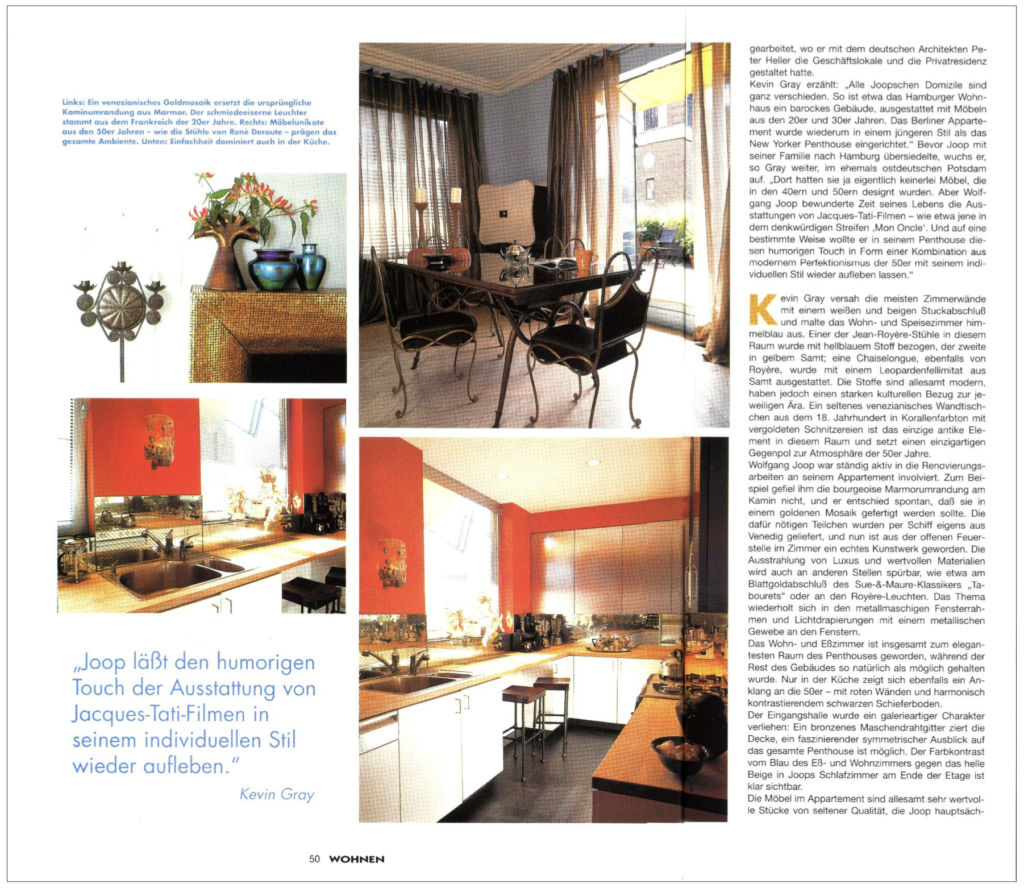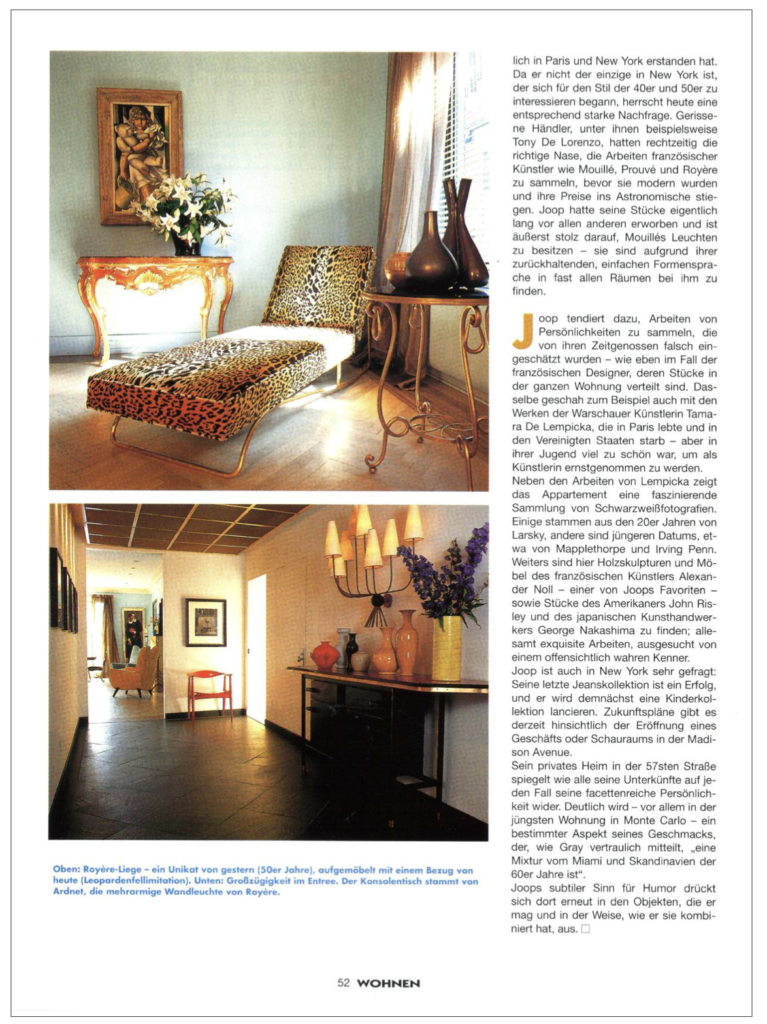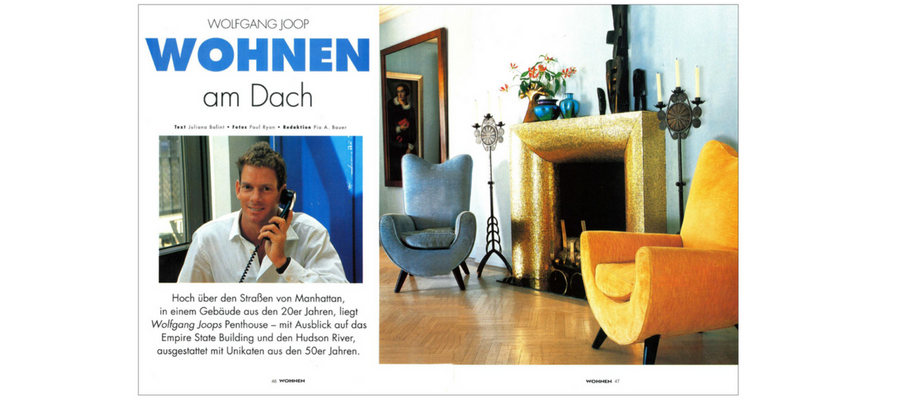Featured in Wohnen Magazine: Translated from German to English by Patricia Goren.
We recently celebrated the 25-year anniversary of Wendy Goodman’s HG article on JOOP and the Sutton Place NYC penthouse I designed for Wolfgang Joop. Shortly thereafter, as I was sorting through my mother’s home, I came across an issue of Wohnen magazine published 25 years (back in my good old ‘hair” days) ago that my mother had saved all these years – something I had forgotten about and with photos and copy that have never been published in the United States.
Wolfgang Joop: Wohnen am Dach
Text by Juliana Balint, Photography by Paul Ray, Editor, Pia A. Bauer
Wolfgang Joop’s penthouse is situated high above the streets of Manhattan in a building from the 1920s – it has a view of the Empire State Building and the Hudson River and is furnished with unique pieces from the 1950s.
A 15-story edifice built in the early 1920s, just before the onset of The Great Depression, is located on fashionable 57th Street in New York’s East Side. This building has been home to countless countless celebrities – among the Marilyn Munroe, Arlene Dahl and Susie Parker – who maintain their residences here. Even today prominence can be found under this roof, like iconic gallerist Holly Solomon.
The rooftop of the building features an elegant penthouse with a panoramic view of the city: below it is the entire New York City skyline, with the towering Citicorp Center, Chrysler Building and Empire State Building in the foreground and a breathtaking view of the bridges that stand the Hudson River behind them. This penthouse once belonged to fashion designer Bill Blass. Now Wolfgang Joop, another master of the fashion genre, is the lucky owner. His decision to make this 57th Street address his base in New York led to the apartment’s complete refurbishment. Blass’ outspoken pension for Anglophile style had to yield to a picture of contrast; namely an interior that interpreted the style of the 1950s with a 1990’s touch. The special character of the décor was created by using only one-off designer pieces – all specially commissioned from prestigious designers.
Today the Joop! name represents a premium quality European and global brand for fashion, cosmetics and perfume. The German-born designer started his career as fashion editor at “Neue Mode” magazine in Hamburg, subsequently designing furs and women’s fashion and ultimately switching to design for men’s fashion and accessories – which constitutes the focus of his current business activities. Additionally, in cooperation with the Lancaster Group, he launched a high-end line of cosmetic products and fragrances. Aside from his indisputable talent as a designer, the strong popularity of the brand is also due in part to Joop’s charm and good looks, which make him the perfect figurehead to promote his company.

When Joop rebuilt his apartment, he rallied together professionals who understood his vision and preferences. Renovations took six months to complete and were overseen by the meticulous eye of New York architect Brian Kaye and Texan-born interior designer Kevin Gray. Gray had worked previously for Joop in Hamburg, where he collaborated with German architect Peter Preller to design the Joop stores and his private residence.
Kevin Gray provides some insight: “All of Joop’s properties are quite different, For instance, the Hamburg villa is a Baroque building furnished with pieces for the 20s and 30s, while the Hamburg apartment features a more modern look than the New York penthouse.” Before Joop and his family relocated to Hamburg, adds Gary, the designer was raised in the former East German city of Potsdam. “The actually didn’t have any furniture there that had been designed in the 40s or 50s. But Wolfgang Joop had always loved the furnishings used in Jacques Tati movies – for instance in the memorable product ‘Mon Oncle.’ It was his vision to recreate this humorous and playful feeling in his penthouse by combining the modern perfectionism of the 1950s with his own personal style.”
Kevin Gray topped the walls with crown moldings in white and beige and painted the living and dining rooms in sky blue. He had one of the Jean Royère chairs in this room upholstered and light blue velvet and the other in yellow. A chaise long, also designed by Royère, was covered in a leopard print velvet. Although all of the fabrics or modern, they bear a strong cultural reference to that era. A rare 18th-century Venetian wall table in a coral tone with gold carving is the only antique element in this room and creates a unique contrast to the 1950s atmosphere.
Wolfgang Joop was always actively involved in the renovation work that took place in his apartment. For example, he didn’t care for the bourgeois marble facing that framed the fireplace and spontaneously decided to have that changed to gold mosaic tiling. The tiles arrived by ship all the way from Venice and have turned this open hearth into a real work of art. The aura of luxury and precious materials is also evident and other details, like the gold leaf finishing on the classics stools by Süe and Mare “Tabourets” or on the Royère lamps. This theme is repeated in the metal mesh window frames and sheer drapes in metallic netting that hang in the windows.

“Joop enables a revival of the humor presented in Jacques Tati films.”
– Kevin Gray
The combination living-dining room is undoubtedly the most elegant room in the penthouse, while the rest of the space has been kept as natural as possible. The only other room where the fifties look prevails is the kitchen – with its red walls and harmoniously contrasting black slate flooring.
The character of the entrance hall is reminiscent of an art gallery: bronze wire mash adorns the ceiling and a fascinating symmetrical view of the entire penthouse is possible from here. From this vantage point, the contrasting colors of the blue dining and living area against the light beige of Joop’s bedroom at the end of this level can be clearly seen.
The character of the entrance hall is reminiscent of an art gallery: bronze wire mash adorns the ceiling and a fascinating symmetrical view of the entire penthouse is possible from here. From this vantage point, the contrasting colors of the blue dining and living area against the light page of Joop’s bedroom at the end of this level can be clearly seen.
The apartment features a collection of extremely valuable pieces in rare quality, which Joop mainly acquired in Paris and New York. Since he isn’t the only person in New York with an interest in furniture for the 40s and 50s, these are currently in high demand. Smart dealers, including Tony de Lorenzo, recognized this trend early on and were able to amass works from French artists like Mouille, Prouvé, and Royère before their popularity – and their prices – rose to astronomical heights. Joop was able to acquire his pieces long before most others and is the extremely proud owner of Mouille lamps – these feature a restrained, simple design and are therefore present in almost all rooms.
Joop has a tendency to collect works particularly from those personalities who have been misunderstood by their contemporaries – as in the case of the French designer whose pieces are scattered throughout the apartment. This also holds true for the works of Warsaw-born artist Tamara de Lempicka. Born in Poland, she lived in Paris and later died in the United States – but her beauty prevented her art from being taken seriously during her lifetime.

In addition to works from de Lempicka, the apartment displays a fascinating collection of black-and-white photography. Some by Larsky, taken in the 1920s, others are more recent works by the likes of Mapplethorpe and Irving Penn. There are also wood sculptures and furniture from French artist Alexander de Noll – one of Joop’s favorite – along with pieces from American John Risley and furniture from Japanese-American woodworker George Nakashima; each one of them exquisite works obviously chosen by an expert. Joop! is also in great demand in New York: his most recent jeans collection is a success and a children’s collection will be launched soon. Future plans even include opening a shop or showroom on Madison Avenue.
As with all his properties, his private residence on 57th Street reflects his multifaceted personality. One particular aspect of his taste clearly surfaces, especially in the new apartment in Monte Carlo, which Gray discreetly describes as “a mixture of Miami and 1960s Scandinavia.”
Joop’s subtle sense of humor is once again expressed there in the objects that he likes and the way that he combines them.
Click here to see the original Joop penthouse photos and article in Wohnen magazine.


